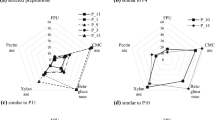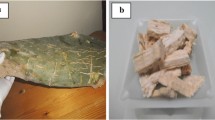Abstract
Novel cellulose fibres (Biocelsol) were spun by traditional wet spinning technique from the alkaline solution prepared by dissolving enzyme treated pulp directly into aqueous sodium zincate (ZnO/NaOH). The spinning dope contained 6 wt.% of cellulose, 7.8 wt.% of sodium hydroxide (NaOH) and 0.84 wt.% of zinc oxide (ZnO). The fibres were spun into 5% and 15% sulphuric acid (H2SO4) baths containing 10% sodium sulphate (Na2SO4). The highest fibre tenacity obtained was 1.8 cNdtex−1 with elongation of 15% and titre of 1.4 dtex. Average molecular weights and shape of molecular weight distribution curves of the celluloses from the novel wet spun cellulosic fibre and from the commercial viscose fibre were close to each other.











Similar content being viewed by others
References
Bernfeld P (1955) Amylases, α and β. In: Colowick SP, Kaplan NO (eds) Methods in enzymology, vol 1. Academic Press, NY, pp 149–158
Brumberger H, Delaglio F, Goodisman J, Whitfield M (1986) Small-angle X-ray scattering analysis of catalysts: comparison and evaluation of models. J Appl Cryst 19:287
Ellefsen O, Kringstad K, Tonnesen BA (1964) The structure of cellulose as judged by X-ray methods. Norsk Skogindustri 11:1
Fink H-P, Weigel P, Purz HJ, Ganster J (2001) Structure formation of regenerated cellulose materials from NMMO-solutions. Prog Polym Sci 26:1473–1524
Goodisman J, Brumberger H (1971) Scattering from a multiphase system. J Appl Cryst 4:347
Götze K (1967) Chemiefasern nach dem Viskosverfahren, Erster Band, 3. Auflage, Berlin/Heidelberg/New York, Springer-Verlag, p 778
Hindeleh AM, Johnson DJ (1971) The resolution of multipeak data in fibre science. J Phys (D) 4(2):259
Hindeleh AM, Johnson DJ (1978) Crystallinity and crystallite size measurement in polyamide and polyester fibres. Polymer 19:27
IUPAC (International Union of Pure, Applied Chemistry) (1987) Measurement of cellulase activities. Pure Appl Chem 59:257–268
Matero M (1991) Selluloosan pilkkoutumisen tutkiminen GPC:llä viskoosikatkokuituprosessissa (Applicability of GPC to the evaluation of dissolving pulps in the viscose process). Master of Science Thesis, Tampere University of Technology, Finland, confidential work, limited publicity
Matero M, Nousiainen P, Struszczyk H, Ciechańska D, Wawro D, East G (1996) Celsol – Biotransformation of cellulose for fibre spinning. In: Kennedy JF, Phillips GO, Williams PA (eds) The chemistry and processing of wood and plant fibrous materials. Woodhead Publishing Limited, Cambridge
Mitchell RL, Daul GC (1990) Rayon. In: Encyclopedia of polymer science and technology, 2nd edn. A Wiley-Interscience Publications, John Wiley & Sons, pp 45–71
Morton WE, Hearle JWS (1993) Physical properties of textile fibres, 3rd edn. The Textile Institute, UK, p 725
Rabiej M (2002) Determination of the degree of crystallinity of semicrystalline polymers by means of the “OptiFit” computer software. Polimery 47:423
Rahkamo L, Siika-Aho M, Vehviläinen M, Dolk M, Viikari L, Nousiainen P, Buchert J (1996) Modification of hardwood dissolving pulp with purified Trichoderma reesei cellulases. Cellulose 3:153–163
Struszczyk H, Ciechańska D, Wawro D, Nousiainen P, Matero M (1995) Direct soluble cellulose of Celsol: properties and behaviour. In: Kennedy JF, Phillips GO, Williams PA, Piculell L (eds) Cellulose and cellulose derivatives: physico-chemical aspects and industrial applications. Woodhead Publishing Limited, Cambridge, England, pp 29–35
Struszczyk H, Ciechańska D, Wawro D, Urbanowski A, Wrzesniewska-Tosik K (2001) Method for the manufacture of fibres, film, and other products from modified soluble cellulose, PCT WO 01/96402 A1
Vehviläinen M, Nousiainen P (1997) Celsol – Modification of pine sulphate paper grade pulp with Trichoderma reesei cellulases for fibre spinning. In: Proceedings of the Akzo Nobel viscose chemistry’s seminar: cellulosic man-made fibres, Singapore, 22–24 April 1997
Wilkes AC (2001) The viscose process. In: Woodings C (ed) Regenerated cellulose fibres. The Textile Institute, Woodhead Publishing Limited, Cambridge, pp 37–61
Acknowledgments
The research was carried out in the EU FP6 project Biocelsol—Biotechnological Process for Manufacturing Cellulosic Products with Added Value, with contract number of NMP2-CT-2003-505567. The authors wish to thank European Commission for partly financing the work. The authors wish also to thank Teija Jokila and Nina Vihersola, VTT Biotechnology, for their excellent laboratory work related to the enzymatic treatments, Maija Järventausta and Esa Leppänen, Tampere University of Technology, for their excellent contribution in fibre spinning trials and fibre testing and Dr Ryszard Kwiatkowski of the University of Bielsko-Biała for valuable discussion on structural parameters. The text reflects only the authors’ views and the Community is not liable for any use that may be made of the information contained therein.
Author information
Authors and Affiliations
Corresponding author
Rights and permissions
About this article
Cite this article
Vehviläinen, M., Kamppuri, T., Rom, M. et al. Effect of wet spinning parameters on the properties of novel cellulosic fibres. Cellulose 15, 671–680 (2008). https://doi.org/10.1007/s10570-008-9219-3
Received:
Accepted:
Published:
Issue Date:
DOI: https://doi.org/10.1007/s10570-008-9219-3




